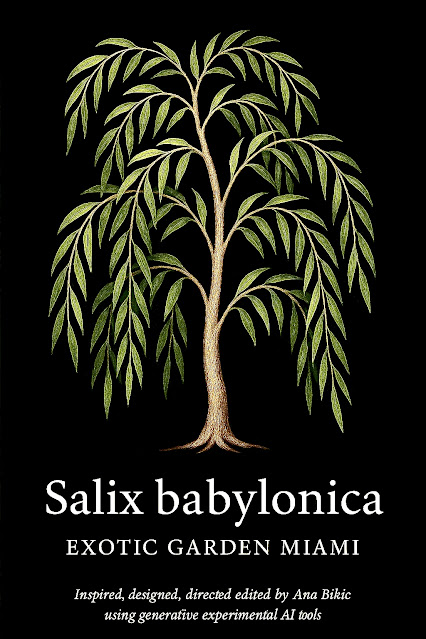Check the Complete List of Plants, Trees, Ornamental and Medicinal Plants
🌳 Salix babylonica – Weeping Willow
Herbal Medicinal Tree for Exotic Tropical Gardens in Miami
Scientific Name:
Salix babylonica
Place of Origin:
Native to northern China, spread across the Middle East and the Mediterranean since ancient times.
Growing Zone:
USDA Zones 6–9. Suitable for South Florida with careful irrigation.
Soil:
Moist, rich, well-drained loamy soils. Tolerates clay and occasional flooding.
Light:
Full sun to partial shade.
Watering & pH:
High water needs; thrives in consistently moist soil. pH 5.5–7.5 (slightly acidic to neutral).
Toxicity:
Not toxic to humans or pets. Salicin may affect individuals sensitive to aspirin.
Care & Containers:
Can be grown in large pots when young; needs frequent watering and pruning. Not ideal for small urban patios due to its aggressive roots.
Pests & Insecticidal Properties:
Susceptible to aphids, borers, and caterpillars. Extracts show mild insect-repelling qualities due to salicylic acid.
Cultural & Historical Use:
Revered in Babylon, Egypt, and China for mourning rituals, water purification, and symbolism of grief and resilience.
Medicinal Properties:
Contains salicin, the precursor to aspirin. Historically used for fever, pain, inflammation, and headaches.
Vitamins & Health Uses:
Leaves and bark have antioxidant polyphenols; used for anti-inflammatory and analgesic herbal teas.
Lab Studies:
-
Analgesic & anti-inflammatory effects: Salicin shown to inhibit prostaglandin production.
-
Antioxidant capacity: Research confirms high phenolic content for cellular protection.
-
Antimicrobial potential: Extracts show promise against skin bacteria.
Other Uses:
-
Erosion control near rivers
-
Used in traditional Chinese medicine
-
Symbolic in art and literature
-
Wood for wicker, crafts, and lightweight construction
Medicinal tree for tropical gardens, Herbal uses of Weeping Willow bark, Anti-inflammatory natural pain reliever, Exotic garden tree South Florida, Weeping Willow care for large gardens, Natural source of salicylic acid, Moisture-loving tree for pond edges, Traditional Chinese medicine plants, Trees for riverbank restoration
🌿 Historical and Medicinal Significance of Salix babylonica (Weeping Willow)
🏺 Ancient and Cultural Importance:
-
Ancient Mesopotamia & Babylon: The name babylonica references the tree's dramatic presence along the Euphrates River, where it was seen as a symbol of sorrow and renewal. It’s often associated with mourning and poetry in many ancient cultures, including Hebrew psalms and Chinese verse.
-
China: Used in traditional Chinese medicine (TCM) for centuries. It was believed to calm fevers, reduce swelling, and ease pain—long before Western science isolated its active compound.
-
Egypt & Greece: Known to healers for treating joint inflammation, fevers, and headaches. Hippocrates himself is believed to have prescribed willow bark.
🧪 Medicinal Lab Studies and Pharmacological Research:
✅ Modern Discoveries:
-
Salicin: The primary compound found in willow bark, salicin, was isolated and eventually synthesized into acetylsalicylic acid, commonly known as aspirin. Willow is essentially the natural origin of aspirin.
-
Anti-inflammatory Effects: Recent lab studies confirm that salicin reduces levels of prostaglandins, which are involved in pain and inflammation.
-
Antioxidant Properties: New research reveals that willow bark contains polyphenols and flavonoids with strong antioxidant capacity, offering benefits in slowing aging-related oxidative damage.
-
Antimicrobial Activity: Extracts show potential against Staphylococcus aureus and other harmful skin bacteria, making it suitable for topical antiseptics and natural skincare.
🌱 Other Medicinal and Practical Uses:
🌿 Rooting Hormone (Auxin Booster):
-
Willow bark water (soaked twigs in water) creates a natural rooting hormone due to the indolebutyric acid (IBA) and salicylic acid it contains.
-
Commonly used by organic gardeners and permaculture practitioners to root cuttings of other plants.
🌍 Ecological & Environmental Uses:
-
Phytoremediation: Used to clean polluted soils and remove heavy metals from contaminated water.
-
Erosion Control: Fast-growing root systems stabilize riverbanks, making it ideal for flood-prone areas.
🧵 Economic & Industrial Uses:
-
Basketry & Craft Wood: The flexible branches are still used in basket weaving, furniture frames, and lightweight wood crafts.
-
Bioenergy & Carbon Sequestration: Its fast growth makes it a potential candidate for biomass fuel and carbon-offset planting.
-
Perfume and Skincare: Willow extract is added to natural skin products for its gentle astringent and soothing qualities.
-
Pet Products: Used in rabbit and guinea pig chews, as it’s safe and helps wear down teeth naturally.
🧾 Economic and Herbal Value:
Salix babylonica is more than just a weeping tree—it’s an ancient pharmacy, a natural engineer, and a sustainable resource. From inspiring poets to launching the age of modern medicine (via aspirin), it continues to provide environmental, economic, and medicinal value today. In many ways, it’s one of the most underappreciated crops in modern landscapes.



Comments
Post a Comment